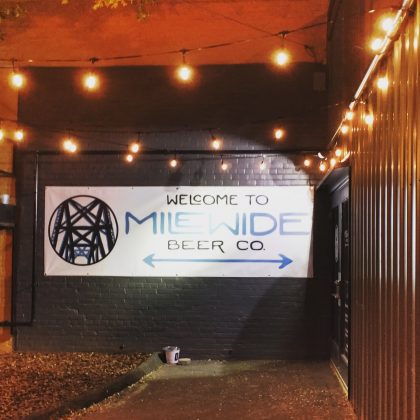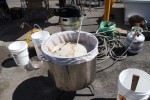 I promise to try and find some less science-y topic next time, but for no reason I can easily discern, I felt like writing about boiling today. Doesn’t seem that interesting? We all know about boiling. We all know you have to boil wort before it becomes beer. But what do we really know about it? It occurred to me that I knew tragically little, so I did some reading up on what happens in the boil, and man is there a lot. Time to share a little bit of what I picked up.
I promise to try and find some less science-y topic next time, but for no reason I can easily discern, I felt like writing about boiling today. Doesn’t seem that interesting? We all know about boiling. We all know you have to boil wort before it becomes beer. But what do we really know about it? It occurred to me that I knew tragically little, so I did some reading up on what happens in the boil, and man is there a lot. Time to share a little bit of what I picked up.
While there are certainly more things that occur in a boil that I will be covering here, I wanted to take a brief pass at five processes:
- Sanitization
- Browning reactions
- Effect on hops
- Haze reduction
- DMS volatilization
Sanitation is perhaps the most obvious function of boiling wort. There are potentially all kinds of organisms that were living on the grain in your mash and could have ended up in your wort. What is less obvious is the difference between sanitization and sterilization. While one or two minutes of boiling will kill all the active microorganisms in your wort (sanitize), it will not eliminate all the potential spores floating around in there (sterilize). What this means is that the living processes of bacterial, fungal, or other potential infections will not occur in your boiling wort, but if you have allowed spore-forming critters to take hold, they could make little babies that will wait until post-boil to wake up and wreak havoc on your beer. By all means, sanitize, but don’t mistake that wort for sterile.
Browning (or Maillard) reactions are a cool set of non-enzymatic, heat-induced chemical reactions that impact both color and flavor. These reactions also occur in very significant ways in the kilning of the grains but also occur in the boil. The color component functions exactly as the name would lead you to believe. As more heat is added to the wort, it slowly becomes a darker brown. The flavor impact is a little more multifaceted. Maillard reactions produce, among other flavorful by-products, melanoidins. These lend full, “malty” flavors to the final product. By-products of this reaction both in kilning and in the boil can also lend roasty, astringent, toffee, and caramel flavors. Yay!
The impact of boiling on hops is a complex one, but we will boil it down (get it?!) to two issues: isomerization of alpha acids and volatilization of oils. By throwing hop cones (whole or pelletized) into boiling wort, you immediately start making a trade-off. The longer a hop is boiled, the more both of these processes will occur. When alpha acids isomerize they create the flavor compounds that we perceive as bitterness. Hence the larger impact on IBUs of hops added early in the boil than the same hops added late in the boil. This bitterness is often desirable to balance the sweetness of the malt. The procuring of bitterness via alpha acid isomerization isn’t free, though. As the hops boil, one of the other vital components of hops, the essential oils, volatilize and leave the wort. This is a problem because many of the characteristic flavors that we think of as “hoppy” come primarily from these oils such as humulene and myrcene. These two processes acting in tandem are responsible for the common brewing knowledge that early hops are mostly for bittering and late hops are mostly for flavor and aroma.
The next important factor in wort boiling is that of haze reduction. The addition of heat can cause the coagulation and precipitation of proteins that, if left to their own devices, would float around in the finished product making it appear hazy. Two forms these proteins can take are hot break and cold break. The hot break forms at or near boiling and can be skimmed off the top as well as settled to the bottom after boil. It is primarily composed of the coagulated proteins derived from the malted grain. Cold break is slightly more complex. The precursors are formed during the boil and the actual proteins do not precipitate out until the wort has cooled. Given time or some form of filtration, this cold break is easily removed from the final product. One interesting practical tip is that different proteins come out of solution at different temperatures. This mean that it is only possible to mechanically remove proteins that have precipitated out at the temperature the removal is taking place. In other words, even filtered beer may develop a “chill haze” at temperatures below that at which the beer was filtered.
The last part of boiling we are going to touch on today is dimethyl sulfide (DMS) volatilization. DMS creates a strange, often unpleasant sulphury flavor that is undesirable in most beers, although some styles can have acceptable levels of DMS. DMS can come from a variety of sources, but in beer tends to be formed mostly by adding heat to S-methyl methionine (SMM), a necessary byproduct of malt germination. The difficulty in this scenario is that SMM will convert to DMS at 158 degrees Farenheit, but DMS is not driven off until boiling at 212 degrees. DMS production seems unavoidable because we need to boil for all the reasons discussed above, and, indeed, unconverted SMM can potentially produce some off flavors of its own. The big threat is that this dangerous temperature window wherein DMS is created but not driven off can happen after the boil as well. This is one of the reasons for rapid cooling of the wort once the boil has ended. Once the wort drops back below 158 degrees, DMS production stops. Again, yay!
Hopefully that was an illuminating and/or entertaining romp through some of my favorite parts of boiling flowery sugar water. How’s all the science working out for you? Not too bad, I hope. Next time I’ll try to take a brief departure from chemistry and tackle something else for the week. Until then, faithful readers, thanks for reading, and happy drinks!
P.S. Remember to let me know if you have some specific topic you would like me to babble about next time. You can tell me in person, by e-mail, or in the comments right down below.





